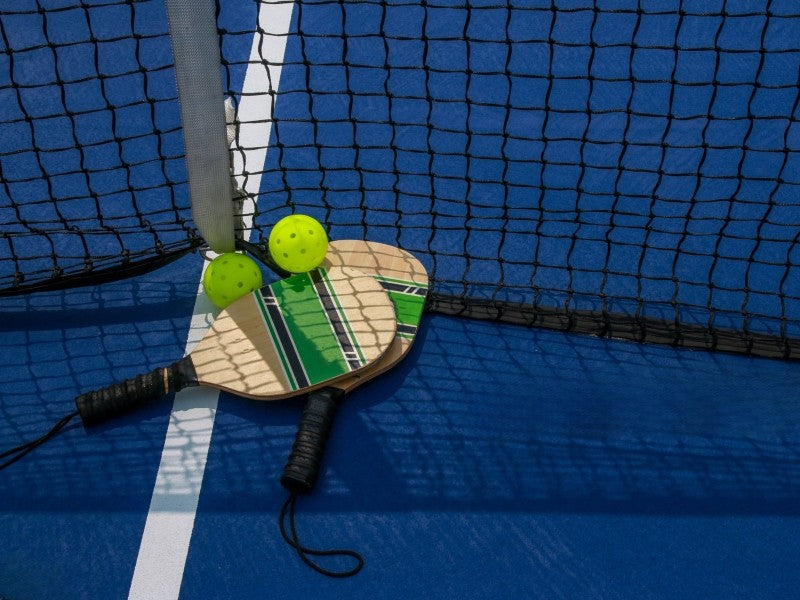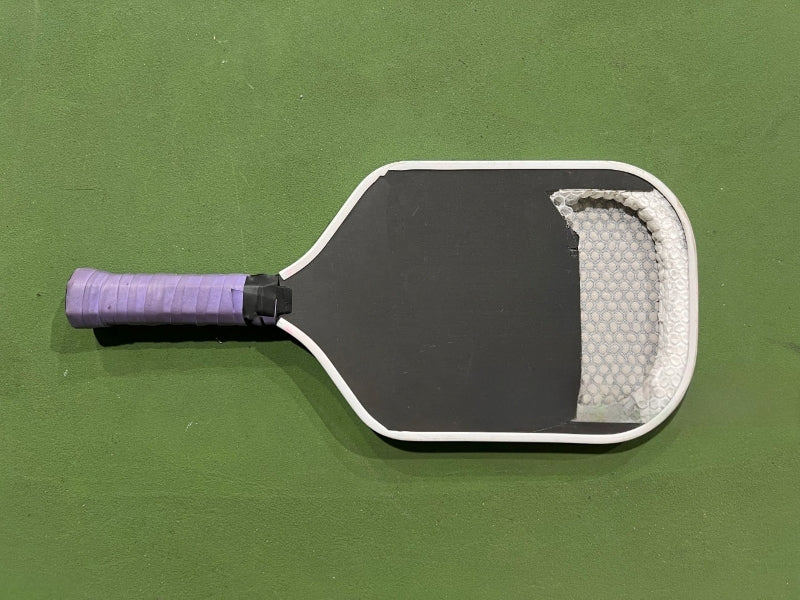Pickleball has grown into one of the fastest-rising sports worldwide, and along with its popularity comes a flood of equipment options. If you’re new to the game—or simply curious—you might be asking the common question: are wood pickleball paddles good?
The quick answer is: wood paddles can be a great fit in certain situations, but they aren’t the best choice for every player. Their appeal lies in affordability, durability, and accessibility, but they also come with trade-offs in weight, control, and advanced playability.
What Are Wood Pickleball Paddles? Construction, Materials & Varieties
Wood paddles are the original style of pickleball paddle, dating back to the game’s invention in the 1960s. While the market is now dominated by composite and graphite paddles, wood models still occupy an important niche.
Construction and Materials
- Solid hardwood paddles: Carved from a single piece of maple, ash, or other hardwood. These are heavy and extremely durable but less common today.
- Plywood or laminated paddles: Multiple thin wood layers are pressed together for greater strength and reduced warping. These are widely used in recreational sets.
- Wood veneer over composite core: Some modern hybrids feature a composite or polymer core with a thin wood layer on the face, combining tradition with improved performance.
Typical specs for wood paddles:
- Weight: Generally 9–14 ounces, noticeably heavier than modern paddles (average 7–8 ounces).
- Grip: Usually simple, cushioned handles wrapped in synthetic material; cheaper paddles may have minimal grip.
- Edge guard: Some come with plastic edge guards to prevent chipping; others are plain wood.
- Shape & size: USAPA-compliant paddles must meet specific dimensions (not exceeding 24 inches in length and width combined), and wood paddles are often larger-faced for easier contact.
Why Wood Is Still Used
- Affordability: Basic wood paddles can cost as little as $10–$20, making them the most budget-friendly option.
- Durability: They hold up well to rough handling, outdoor storage, or being shared among many players.
- Accessibility: Parks departments, schools, and community centers often stock wood paddles for loaner programs.
Are They Legal in Competition?
Most wood paddles are USAPA-approved for recreational play, but many are not optimized for competitive matches. Players aiming for tournaments usually transition to composite or graphite paddles.
Performance: Power, Control, Spin, Weight & Feel
Performance is the heart of the question: are wood pickleball paddles good when it comes to actual gameplay? Let’s break down the major performance categories.
Power & Pop
Wood paddles are heavy and rigid, which translates into raw hitting power. A firm swing can send the ball back quickly with minimal effort. This can be advantageous for beginners who struggle to generate pace. However, the downside is reduced maneuverability—especially at the net, where quick reactions are key.
Control & Touch
Control is where wood paddles struggle. Because of their weight and stiffness, it’s harder to “feel” the ball and execute delicate shots such as dinks, drops, or spins. Experienced players often find wooden paddles unforgiving when trying to place the ball with precision.
Spin Potential
Modern composite paddles feature textured faces designed to grip the ball and create spin. By contrast, wood paddles typically have smooth surfaces, making spin generation minimal. For players whose game relies on topspin or slice, wood won’t deliver the same performance.
Sweet Spot & Consistency
Wood paddles tend to have less consistent sweet spots. Off-center hits can feel harsh and lead to mis-hits. Newer players may not notice this as much, but advanced players will quickly feel the difference compared to graphite or polymer paddles.
Weight & Fatigue
A typical wooden paddle weighs between 9 and 14 ounces. The extra weight can help in driving the ball but often causes arm fatigue during long matches. For youth players, seniors, or those prone to elbow issues, the heaviness can be a significant drawback.
Real-World Scenarios
- Beginner rallies: Wood paddles are fine for learning the rules and rallying casually.
- Fast exchanges at the kitchen line: The heavier paddle slows reaction time, making quick volleys more challenging.
- Outdoor recreational play: Wood paddles withstand rough use, cement courts, and shared handling without much concern.
- Competitive drills: Advanced drills reveal the paddle’s limitations in finesse and spin.
In summary, wood paddles deliver raw power and durability but compromise on control, touch, and spin—the very aspects that define advanced play.

Comparison: Wood vs. Composite vs. Graphite Paddles
When evaluating are wood pickleball paddles good, it’s essential to place them side by side with the most common modern options.
|
Feature |
Wood Paddles |
Graphite Paddles |
|
|
Price |
$10–$30 |
$50–$120 |
$70–$200 |
|
Weight |
9–14 oz (heavier) |
7–9 oz (medium) |
6–8 oz (lightest) |
|
Power |
Strong due to weight |
Balanced |
Excellent speed + power |
|
Control |
Limited |
Good, versatile |
Excellent precision |
|
Spin |
Minimal (smooth face) |
Good (textured surface) |
Very good (textured, responsive) |
|
Durability |
Very durable but prone to chipping |
Durable with polymer cores |
Durable but face may scuff |
|
Best For |
Beginners, schools, budgets |
All-around players |
Competitive & advanced players |
Key Takeaways
- Wood: Best for affordability and durability. Heavy and less refined.
- Composite: The most balanced option—good mix of power, control, and spin.
- Graphite: High-performance paddles for serious players wanting speed, touch, and finesse.
Best Uses & Ideal Player Profiles
So, who benefits most from wood pickleball paddles?
1. Beginners Trying the Sport
- If you’re not sure you’ll stick with pickleball, a $15–$20 wood paddle is a low-risk investment.
- Great for learning rules, court positioning, and rally basics.
2. Community Centers & Schools
- Wood paddles are the standard choice for loaner programs.
- They’re tough enough to withstand daily use from dozens of players.
3. Casual & Family Play
- Perfect for backyard games or casual matches with friends.
- Less worry about damaging an expensive paddle.
4. Budget-Conscious Players
- Those who want to play regularly but don’t want to spend $70+ on a graphite paddle.
5. Not Ideal For…
- Players focused on spin-heavy or control-based strategies.
- Competitors training for tournaments.
- Seniors or players prone to wrist/shoulder issues, as paddle weight may cause strain.
Maintenance & Care Tips for Wood Paddles
While wood paddles are durable, a little care extends their life:
- Avoid prolonged moisture: Wood absorbs water, which can warp the paddle. Don’t leave it outside in the rain.
- Store properly: Keep in a dry, cool place. Avoid leaving it in a hot car, as heat can weaken adhesive layers.
- Protect the edge: If your paddle doesn’t have an edge guard, consider adding tape to prevent chips.
- Check grip regularly: Replace worn or slippery grip tape for better handling.
- Use indoors when possible: Outdoor play accelerates wear, especially on rough concrete.
With proper care, a wood paddle can last years—even with frequent recreational use.
Are Wood Pickleball Paddles Good?
The answer depends on who you are as a player.
· Yes, they are good if you’re a beginner, casual player, or part of a school/community program. They’re cost-effective, durable, and perfectly adequate for recreational fun.
· No, they’re not the best choice if you’re seeking finesse, spin, and control at a competitive level. In that case, composite or graphite paddles are worth the investment.
Think of wood paddles as an entry-level tool: excellent for starting out, experimenting, or playing casually—but not the long-term solution for serious players.
So, next time someone asks, “are wood pickleball paddles good?”, the most accurate answer is:
They’re good for learning and casual fun, but limited for competitive performance.

FAQs About Wood Pickleball Paddles
1. Are wood pickleball paddles legal for tournament play?
Yes, many are USAPA-approved, but few competitive players use them due to performance limitations.
2. Do wood paddles hurt your arm?
They can cause fatigue or strain because of their extra weight, especially for seniors or those with elbow issues.
3. Can I generate spin with a wood paddle?
Not much. Most wood paddles have smooth faces, so spin potential is minimal.
4. How long do wood pickleball paddles last?
With basic care, they can last several years, especially in recreational or indoor settings.
5. Should a beginner start with a wood paddle?
Yes—if cost is the main concern. But if you plan to play frequently, starting with an affordable composite paddle might be a better long-term choice.








Leave a comment
This site is protected by hCaptcha and the hCaptcha Privacy Policy and Terms of Service apply.